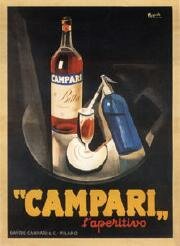Bitter Look into This
By Darryl Beeson
Sometimes spirits are malt, or grain-based; sometimes the taste is neutral or one-dimensional. Aperitifs bring flavors. A step further are bitters, or herbal-driven spirits. Campari might be called “herbals grown wild,” available in video form on a late-night television near you. The fine, but few, fans of Campari find it to be sweet and pleasantly bitter. To many others, though, the mention of Campari brings a negative reaction. Bitter look into this. Only the sophisticated need apply.

Aperitifs are both eye-openers and meal-openers, awakening the appetite and preparing the taste buds with bittersweet flavors. Introduced in Italy in the 1860’s by Gaspare Campari, who was a master drink maker at the Bass Bar in Turin by the age 14. His recipe for Campari contained more than 60 natural ingredients, including herbs, spices, barks and fruit peels. Campari initially named his scarlet colored drink “Bitter all’uso d’Hollandia,” to capitalize on the popularity of Dutch cordials at the time. Obviously the apertif had no connection with Holland. The great, make that perfect, recipe captured converts.
Campari (between 20 and 24 percent alcohol by volume) introduced the modern age of spirits advertising. Bar owners in northern Italy and southern France were “allowed” to buy the in-demand Campari products under the condition that they would display the ‘Campari Bitters’ sign at their location. Campari became very popular.
As bitters go, Campari is a mild bitters-type aperitif, often drunk with soda, orange juice, or in mixed drinks. The formula for Campari is a secret known only to the factory director at the main production facility in Milan. Most are certain that the secret blend contains quinine, rhubarb, ginseng, orange peels and aromatic herbs. These are combined and macerated in a blend of distilled water and alcohol for a couple of weeks. Chinotto has contained a similar flavor, making it a prime ingredient suspect.
In Italy, Campari is served in a frozen glass, using very cold Campari, without ice and with a splash of soda. When you add the soda, you release the flavors. Campari’s bright red color comes from natural carmine, which is derived from cochineal an expensive crimson or carmine dye derived from the cochineal (Dactylopius coccus), a scaled insect in the suborder Homoptera, native to tropical and subtropical South America and Mexico. Yum, yum, better get you some.
In the Italian market and certain others, including Australia, Campari mixed with carbonated water is sold in individual bottles as CampariSoda (10 percent alcohol by volume). CampariSoda was first created in 1932 and is considered the first pre-mixed drink in the world. CampariSoda is packaged in a distinctive bottle designed in the 1930s by Fortunato Depero.
